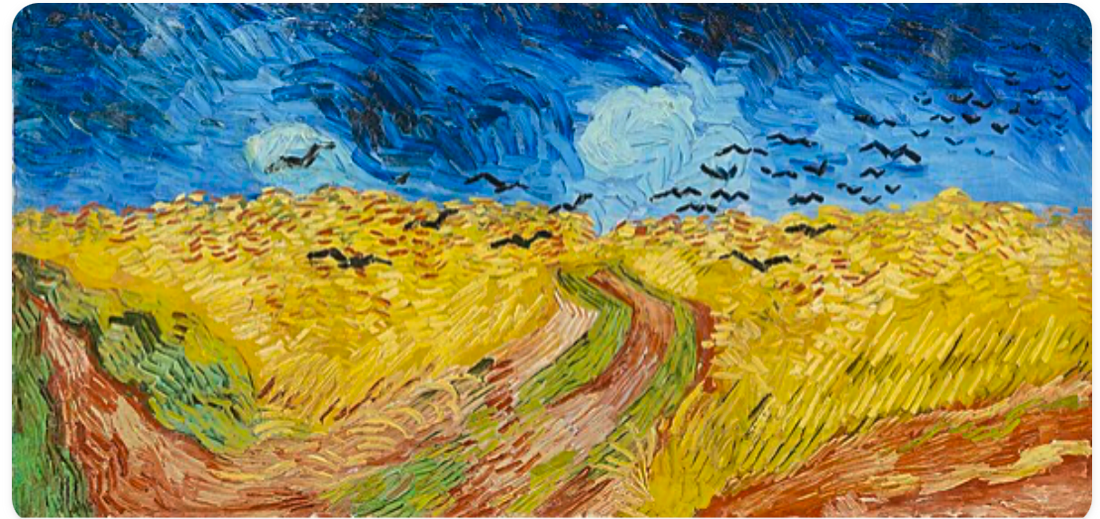Observation is about embracing not just what you see but also observing how you respond to your environment. After all, being an artist or creative is all about expressing your unique take on things.
Expressionist art refers to the expression of subjective emotions, inner experiences and spiritual themes, as opposed to realistic depictions of people or nature. They tapped into their inner emotions to create a looser style of art that evokes mood. I think of expressionism less of a movement in art more a style that has continued to influence art today.
Ask yourself what moves you?
What stirs your soul?
What do you want to express as part of your art?
Van Gogh pioneered expressionism, with his loose brush strokes and stirring landscapes, way before his time, leading the way for expressionism. His style was so unique, sadly in his time his art was not appreciated as he was so ahead of his time.

Wheatfield with Crows, Vincent van Gogh, 1890
Edvard Munch is perhaps the most well known Expressionist. ‘The Scream’ is one of the most acclaimed images today.The distortion of the image is designed to evoke a mood or feeling.

Edvard Munch, The Scream, 1893
Expressionism developed before the First World War, in the early twentieth century, as an avant-garde (innovative, experimental) movement. Tapping into emotions, spirituality and the human experience was a reaction to the dehumanisation following the Industrial Revolution, replacing humans with machines.
Sound familiar in our current Technology Revolution?
The style predominantly originated in Germany and Austria. Here are some examples of prominent Expressionist artists.

Oskar Kokoschka, Seated Old Man, 1907

Egon Schiele, Seated Woman with Bent Knee, 1917

Käthe Kollwitz, The People, 1922
Expressionism is a genre that rises to prominence during social upheaval, as it can be argued all artists and art is expressive. But looking at art history, we see its rise amongst artists is pre world war, and further back The Protestant Reformation, German Peasants’ War and Eighty Years’ War.
On the flip side, we see Expressionism being used as a tool for propaganda to evoke emotion and gain influence - which demonstrates the power of the image.

A Nazi poster, showing starving and homeless Germans, and has the message that Hitler is their only hope for survival (“unsere letzte hoffnung:Hitler” means “Our last hope:Hitler.”)
Post war, we see Francis Bacon taking the themes of pain, hypocrisy and human suffering of war. He was an alcoholic, atheist, gambler, and homosexual in an intolerant age. He questions societal norms, structures of religion in his Pope series, which takes a brutal candid look at power structures and doctrine of the Catholic Church.

Francis Bacon, Screaming Pope, 1949.
Bacon’s paintings depict contorted religious figures in opposition to the composed comforting familiarity context we are used to seeing. He strips them of their control and power. Perhaps that’s what is so disturbing about his tormented solitary figures, which exude pain, rage and fear, with reference to religious ideology. Often framed in a box, this evokes a feeling of being confined, detained, seeking freedom, expression and also has the religious symbolism of a confession box.
Maggi Hambling is one of my favourite artists, for her raw emotional style, which has roots in expressionism. I find her portraits most moving, but she’s also well known for seascapes.
Hambling has painted and drawn many of her loved ones just after death or in the process of dying. Famously, both her mother and father just after death, and then from memory again. She reflects on the UK’s attitude to death after a trip to Mexico, where death and life are intrinsically linked in their culture.
“Death is not constantly shuffled out of sight as it is in England.”
“Drawing my parents and Henrietta in their coffins seems to me quite an obvious thing to do, because it’s the last time you’re going to see them. Anyone you love goes on being inside you, don’t they, when they die?”



The contemporary artist, Tracy Emin’s most recent body of work explores love, desire, death, grief. Her art is disarmingly raw, unfiltered and emotional. She recalls the beauty of honesty in this collection, even if it is painful she is seeking truth in the human experience. ‘The most beautiful thing is honesty, even if it’s really painful to look at’.
I’d like to leave you with a quote from psychologist Viktor Frankl, which to me nicely sums up the creative journey.
“Between stimulus and response there is space. In that space is our power to choose our response. In our response lies our growth and our freedom”.
